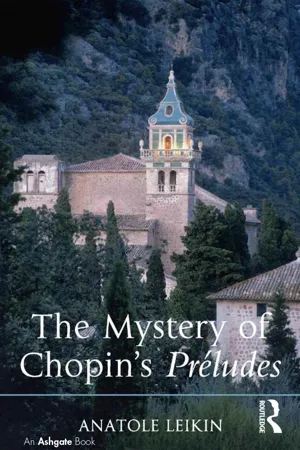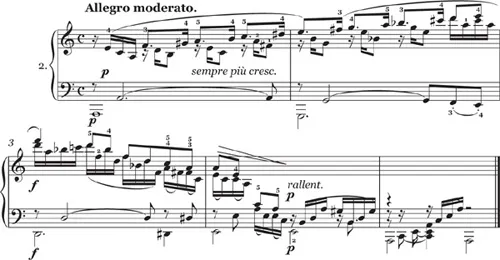![]()
Chapter 1
The Traditions, the Innovations, and the Predicaments
‘Preludes to What?’
When Chopin’s 24 Préludes, Op. 28 were first published in 1839, many of his contemporaries did not quite know what to make of them. In some respects, Opus 28 still remains an enigma today.
It was not the lack of fugues or any other subsequent pieces in Opus 28 that compelled a perplexed Schumann to describe the Préludes as ‘strange pieces,’ ‘sketches’ and ‘ruins,’ ‘a wild motley’ containing ‘the morbid, the feverish, the repellent.’ André Gide’s famous bafflement is a much later development: ‘I admit that I do not wholly understand the title that Chopin chose to give these short pieces: Préludes. Preludes to what? Each of Bach’s preludes is followed by its fugue; it is an integral part of it.’ In this twentieth-century view, Chopin was a trendsetter who dropped the main dish (the fugue) and kept only the appetizer, blazing a trail for the sets of preludes by Debussy, Scriabin, Rachmaninov, Shostakovich, and many others. Chopin’s contemporaries, however, were not in the least bothered by the absence of fugues or any other larger compositions in Opus 28. They knew perfectly well that Chopin’s book of preludes had been preceded by dozens of prelude collections by other composers.
The concert practice of improvising short piano preludes before larger works was common in the late eighteenth through the early twentieth centuries. Preludes were routinely improvised, even on monophonic instruments, such as the flute, and not only before an entire composition but also, quite often, before each movement of a sonata. Many concert reviews of that time mentioned extemporaneous preludes, which Franz Liszt, Hans von Bülow, Anton Rubinstein, and others played before the programmed pieces during their concerts. Unfortunately, since preludes were improvised on the spot, there is no documentary evidence left of how these preludes sounded. One notable exception is some preludes played by Clara Schumann before the compositions she performed in concerts. At her daughters’ request, she wrote a few of them down, even though she complained that writing the preludes was difficult since she played them differently every time.
Clara Schumann’s written preludes are short, between eight and 40 measures. Several of them are rather all-purpose improvisational studies, with no discernible connections to presumed pieces to follow. Four preludes, however, are conceived as specific introductions to Robert Schumann’s works: ‘Des Abends’ and ‘Aufschwung’ from Fantasiestücke, Op. 12, ‘Schlummerlied’ from Albumblätter, Op. 124, and the slow movement of the F-minor Sonata. In each of these four preludes, C. Schumann not only sets the key and the mood of an ensuing composition, but also introduces its thematic material. These preludes, as well as her concert programs and published reviews of her performances, make it abundantly clear that improvised introductions were played before both large-scale compositions and shorter works (including individual sonata movements).
Historical evidence of improvised preludes in public concerts can be found as late as 1945. In the live recordings of Josef Hofmann’s Golden Jubilee Concert at the Metropolitan Opera House on 28 November 1937, and at Carnegie Hall on 24 March 1945, the pianist improvised short preludes before programmed works. The latter included both shorter and larger piano pieces, as well as Hofmann’s own Chromaticon for piano and orchestra.
In the late eighteenth and early nineteenth centuries, when the piano became immensely popular and the number of children and adults studying the instrument grew exponentially, piano methods and instructional books of piano exercises proliferated. One of the main new outgrowths of the piano boom was the etude (or study). Thousands of etudes aimed at the development of piano technique at every level appeared during these decades. The prelude, related to the etude through its purpose of warming up one’s fingers as well as its predisposition for fast passagework, was another flourishing offshoot of the piano’s upsurge.
In response to the public’s hunger for more preludes, numerous prelude collections appeared in print. Many method books offered detailed instructions on prelude improvisation and included numerous sample preludes in various keys. Students, amateur pianists, and even professional pianists of modest improvisational abilities could either modify or memorize these preludes and then perform them in front of an audience before main pieces.
The piano prelude collections published in the nineteenth century prior to Opus 28 consist of preludes written either in the most common keys or in all the keys:
André Ernest Modeste Grétry, Méthode Simple pour Apprendre à Préluder (1801).
James Hewitt, Il Introduzione di Preludio, being an easy method to acquire the art of playing extempore upon piano-forte, interspersed with a variety of examples, showing how to modulate from one key to another, and from which a knowledge of the science of music may be acquired [1810?].
Philip Antony Corri, Original System of Preluding. Comprehending instructions on that branch of piano forte playing with upwards of two hundred progressive preludes in every key and mode, and in different styles, so calculated that variety may be formed at pleasure (1810).
Muzio Clementi, Preludes and Exercises in all major and minor keys (1811).
Johann Nepomuk Hummel, Vorspiele vor Anfange eines Stükes [sic] aus allen 24 Dur und mol Tonarten zum nützlichem Gebrauch für Schüler, Op. 67 (ca. 1814).
Johann Baptist Cramer, Twenty-Six Preludes or short Introductions in the Principal Major and Minor Keys for the Piano Forte (1818).
Tobias Haslinger, XXX Vorspiele in den gebräuchlisten Dur und Moll Tonarten (1818).
Maria Szymanowska, Vingt Exercises et Préludes (1819).
Wilhelm Würfel, Zbiór exercycyi w kształcie preludyów ze wszystkich tonów major i minor (1821).
Ignaz Moscheles, 50 Preludes in the Major and Minor Keys, intended as short introductions to any movement and as preparatory exercises to the authors’ studies, Op. 73 (1827).
Frédéric Kalkbrenner, Twenty-four Preludes for the Piano Forte, in all Major and Minor Keys, being an Introduction to the Art of Preluding (1827).
Carl Czerny, with his characteristic fecundity, produced a staggering quantity of preludes that far outstrips the number of preludes written by any other early nineteenth-century composer: Präludien, Cadenzen und kleine Fantasien im brillanten Style, Op. 61 (1823); 48 études en forme de préludes et cadences dans tous les tons majeurs et mineurs, Op. 161 (1829); Systematische Anleitung zum Fantasieren auf dem Pianoforte, Op. 200 (1836); Die Kunst des Präludirens in 120 Beispielen, Op. 300 (ca. 1834); and 24 préludes dans les tons les plus usités, Op. 501 (1830s).
It goes without saying, of course, that Czerny also provided detailed instructional rules on how to use and improvise preludes. In his textbook on improvisation he described three types of preludes. One is ‘quite short, as though through only a few chords, runs, passagework and transitional materials, one were trying out the instrument, warming up the fingers, or arousing the attention of the listeners. These must conclude with the complete chord of the principal key of the work performed.’ The second type is ‘longer and more elaborate, just like an introduction belonging to the following piece; therefore, even the thematic materials from the latter can be introduced therein.’ The preludes of this kind, according to Czerny, should end on the dominant seventh chord of the following piece. Yet another style of preluding, Czerny writes, is ‘completely unmeasured, almost like a recitative.’
Only some of the printed preludes were intended for specific companion pieces mentioned in the prelude title; these preludes usually incorporated thematic ideas from the following main piece. The vast majority of published preludes were thematically neutral. Czerny, Hummel, and others did recommend, however, that pianists should modify the text of the preludes taken from published collections and individualize the preludes by inserting melodic ideas from the following main pieces.
Another example of this rather indulgent attitude toward the text of a prelude can be seen in Jan Dussek’s Trois Sonates [for pianoforte, flute, violin, and cello] et Trois Préludes Pour le Piano, Op. 31 (ca. 1812), which consists of Sonatas in B♭ major, D major, and C major. The three short piano Preludes, in identical keys (B♭ major, D major, and C major), are not intrinsic parts of the Sonatas, as one would expect. In the score, the individual Preludes do not precede each of the three Sonatas. Instead, all three Preludes are grouped together as an addendum to the score of the Sonatas. There is no verbal instruction by the composer regarding possible connections between the Sonatas and the Preludes or even the order of performance, yet the implicit meaning is not difficult to understand. The pianist is presumed to perform a Prelude before each Sonata, as the custom suggests, but Dussek’s Preludes, discreetly attached at the end, are apparently optional. The pianist may choose to extemporize an introduction before a Sonata; or, lacking improvisatory skills, he or she may simply pull from the addendum the Prelude in an appropriate key and play it instead.
Example 1.1 Hummel, Prelude 1 from 24 Preludes, Op. 67
Example 1.2 Hummel, Prelude 2 from 24 Preludes, Op. 67
The casual treatment of the published preludes—one could change the text, add to it, supplant parts of it, even replace an entire piece—bespeaks their humble ranking among other, more artistic musical genres early in the century. The numerous nineteenth-century pre-Chopin preludes, in spite of their textural variety (arpeggios, scales, occasional intricate passageworks or polyphonic passages, block chords and broken chords, octaves, and instrumental recitatives), had one central trait in common: they were all utterly unremarkable and unmemorable (if pleasant), just as the two Preludes in Examples 1.1 and 1.2.
The Preludes in Examples 1.1 and 1.2 happened to be written by Hummel (as part of his collection of 24 preludes), but they could just as easily have been jotted down by any other composer listed above, or even improvised by a competent pianist. Within this historical context we can better understand George Sand’s statement that Opus 28 was ‘modestly entitled Préludes.’ It must be noted that she did not define Chopin’s Préludes per se as modest; on the contrary, she described them as ‘the most beautiful’ pages of music, and ‘masterworks.’ To us, the title Prelude does not sound any more modest than, for example, a Nocturne, an Impromptu, or an Intermezzo. Yet public perception was quite different back in 1839, as at that time ‘preludes’ were merely utilitarian, didactic pieces with an optional observance of the printed text.
‘A Riddle Wrapped in a Mystery Inside an Enigma’ Underneath a Conundrum
What, ...


